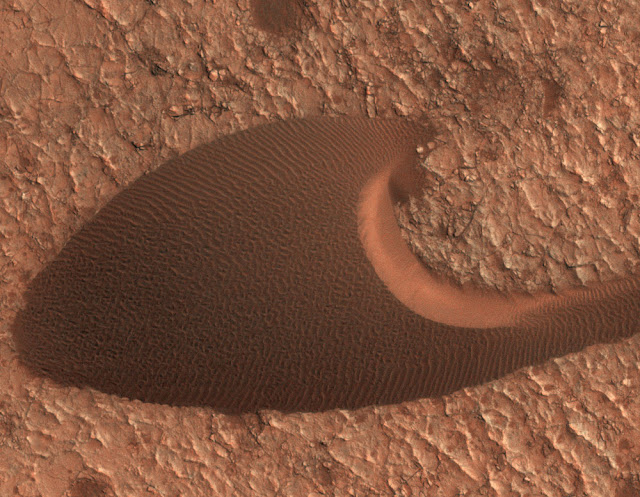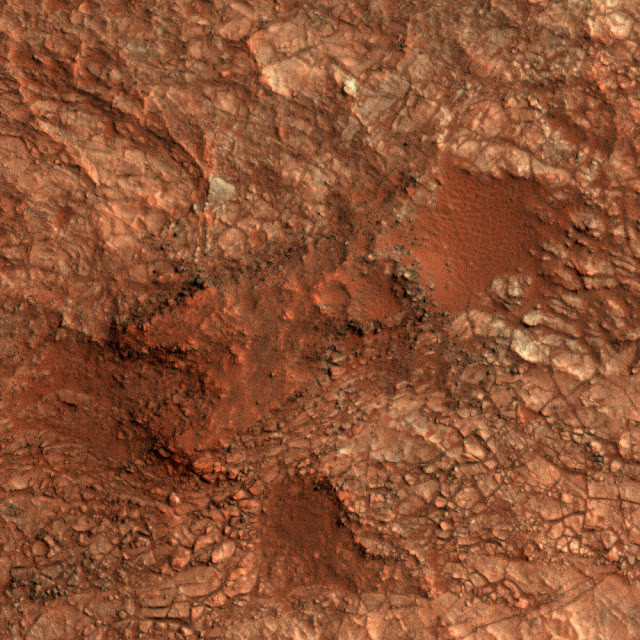Martian dune systems are surprisingly active, overturning the view of Mars as a fairly static environment, with very low erosion rates, US scientists said.
Sand dunes on Mars are darker in colour than on Earth, as the sand is derived from basalt, an iron-rich volcanic rock. And they stand about 60 metres (200 feet) tall at its front edge, with sand avalanches occurring as the dune advanced, said Bridges.
On Earth, dunes form from the accumulation of sand blown by the wind. It has puzzled scientists that Mars has so many dunes, because strong enough winds to move the sand are rare in the planet’s low density atmosphere.
This new research confirms that significant amounts of sand do actually move in today’s Martian environment. Moreover, these large dunes are made up of mobile sand, rather than just being a thin veneer over a solid interior. According to the recent findings, this sand shifting can cause significant erosion of rock and other materials, and thereby modify the landscape of the planet.
“Many areas of Mars show evidence for significant erosion. We show that blowing sand, in the current environment, is the probable mechanism,” said Bridges.
The researchers studied the displacement of sand ripples covering the Nili Patera dune field on the Red Planet using a high-tech camera aboard the Mars Reconnaissance Orbiter, which monitors the planet’s surface from a distance of about 300km.
The study shows that static calm does not prevail at what is called the Nili Patera dune field, and probably not on other areas of Mars, where there are significant gusts of sand and wind. Calculations revealed that sand dunes move volumes of sand equivalent to those in Victoria Valley in Antarctica.
These new observations may explain why vast areas of the Martian surface show evidence of erosion and removal. Over long periods of time, it could be that much or all of Mars has been shaped by large sand fluxes, according to the US scientists.
“Prior to this paper, most researchers believed that dunes and ripples on Mars were essentially fossil features because no direct observations of dune or ripple movement had been made,” said Nicholas Lancaster, an expert on sand dunes at the Desert Research Institute in Reno, Nevada.
Lancaster, who has also published research on Mars dunes, said this paper is the first to unequivocally document and quantify movement of dunes on Mars and compare rates with those observed on Earth.
“Although rates of Martian sand flux are quite low, it is clear that winds capable of transporting sand and causing the migration of large dunes do occur widely on Mars,” said Lancaster.
On Earth, dunes form from the accumulation of sand blown by the wind. It has puzzled scientists that Mars has so many dunes, because strong enough winds to move the sand are rare in the planet’s low density atmosphere.
This new research confirms that significant amounts of sand do actually move in today’s Martian environment. Moreover, these large dunes are made up of mobile sand, rather than just being a thin veneer over a solid interior. According to the recent findings, this sand shifting can cause significant erosion of rock and other materials, and thereby modify the landscape of the planet.
“Many areas of Mars show evidence for significant erosion. We show that blowing sand, in the current environment, is the probable mechanism,” said Bridges.
The researchers studied the displacement of sand ripples covering the Nili Patera dune field on the Red Planet using a high-tech camera aboard the Mars Reconnaissance Orbiter, which monitors the planet’s surface from a distance of about 300km.
The study shows that static calm does not prevail at what is called the Nili Patera dune field, and probably not on other areas of Mars, where there are significant gusts of sand and wind. Calculations revealed that sand dunes move volumes of sand equivalent to those in Victoria Valley in Antarctica.
These new observations may explain why vast areas of the Martian surface show evidence of erosion and removal. Over long periods of time, it could be that much or all of Mars has been shaped by large sand fluxes, according to the US scientists.
“Prior to this paper, most researchers believed that dunes and ripples on Mars were essentially fossil features because no direct observations of dune or ripple movement had been made,” said Nicholas Lancaster, an expert on sand dunes at the Desert Research Institute in Reno, Nevada.
Lancaster, who has also published research on Mars dunes, said this paper is the first to unequivocally document and quantify movement of dunes on Mars and compare rates with those observed on Earth.
“Although rates of Martian sand flux are quite low, it is clear that winds capable of transporting sand and causing the migration of large dunes do occur widely on Mars,” said Lancaster.
Sources:
- Anthony King, Large sand dunes move on Mars, Cosmos Online, May 10, 2012
- Sharon Wilson, Active Sand in Nili Patera, HiRISE, June 8, 2011
- Nathan Bridges, Sand Dunes in Nili Patera Caldera, HiRISE, January 25, 2008
- Nili Patera Ripples, HiRISE (acquisition date 11 May 2010)
- Ripple Movement on Sand Dune in Nili Patera, Mars, NASA MRO, May 9, 2012










